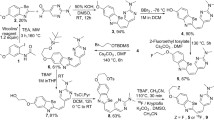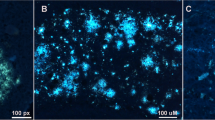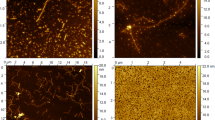Abstract
Alzheimer’s disease (AD) is linked to increased brain deposition of amyloid-β (Aβ) peptides in senile plaques (SPs), and recent therapeutic efforts have focused on inhibiting the production or enhancing the clearance of Aβ in brain. However, it has not been possible to measure the burden of SPs or assess the effect of potential therapies on brain Aβ levels in patients. Toward that end, we have developed a novel radioligand, [125I]TZDM, which binds Aβ fibrils with high affinity, crosses the blood-brain barrier (BBB), and labels amyloid plaques in vivo. Compared to a styrylbenzene probe, [125I]IMSB, [125I]TZDM showed a 10-fold greater brain penetration and labeled plaques with higher sensitivity for in vivo imaging. However, this ligand also labels white matter, which contributes to undesirable high background regions of the brain. Interestingly, parallel to their differential binding characteristics onto fibrils composed of 40 (Aβ40)- or 42 (Aβ42)-amino-acid-long forms of Aβ peptides, these radioligands displayed differential labeling of SPs in AD brain sections under our experimental conditions. It was observed that [125I]IMSB labeled SPs containing Aβ40, amyloid angiopathy (AA), and neurofibrillary tangles, whereas [125I]TZDM detected only SPs and Aβ42-positive AA. Since increased production and deposition of Aβ42 relative to Aβ40 may be crucial for the generation of SPs, [125I]TZDM and related derivatives may be more attractive probes for in vivo plaque labeling. Further structural modifications of TZDM to lower the background labeling will be needed to optimize the plaque-labeling property.
Similar content being viewed by others
References
Agdeppa E. D., Kepe V., Flores-Torres S., Liu J., Satyamurthy N., Petric A., et al. (2001) In vitro binding characteristics of FDDNP and a new analog for synthetic [beta]-amyloid fibrils. J. Nucl. Med. 42, S64P (abstract).
Ashburn T. T., Han H., McGuinness B. F., and Lansbury P. T., Jr. (1996) Amyloid probes based on Congo Red distinguish between fibrils comprising different peptides. Chem. Biol. 3, 351–358.
Bacskai B. J., Kajdasz S. T., Christie R. H., Carter C., Games D., Seubert P., et al. (2001) Imaging of amyloid-beta deposits in brains of living mice permits direct observation of clearance of plaques with immunotherapy. Nat. Med. 7, 369–372.
Dezutter N. A., De Groot T. J., Busson R. H., Janssen G. A., and Verbruggen A. M. (1999) Preparation of 99m Tc-N2S2 conjugates of chrysamine G, potential probes for the beta-amyloid protein of Alzheimer’s disease. J. Labelled Cpd. Radiopharm. 42, 309–324.
Gravina S. A., Ho L., Eckman C. B., Long K. E., Otvos L. J., and Younkin L. H. (1995) Amyloid b protein (Aβ) in Alzheimer’s disease brain. Biochemical and immunocytochemical analysis with antibodies specific for forms ending at Aβ40 or Aβ42(43). J. Biol. Chem. 270, 7013–7016.
Ida N., Hartmann T., Pantel J., Schroder J., Zerfass R., Forstl H., et al. (1996) Analysis of heterogeneous A4 peptides in human cerebrospinal fluid and blood by a newly developed sensitive Western blot assay. J. Biol. Chem. 271, 22908–22914.
Jarrett J. T., Berger E. P., and Lansbury P. T., Jr. (1993) The carboxy terminus of the beta amyloid protein is critical for the seeding of amyloid formation: implications for the pathogenesis of Alzheimer’s disease. Biochemistry 32, 4693–4697.
Klunk W. E., Debnath M. L., and Pettegrew J. W. (1994) Development of small molecule probes for the beta-amyloid protein of Alzheimer’s disease. Neurobiol. Aging 15, 691–698.
Klunk W. E., Debnath M. L., and Pettegrew J. W. (1995) Chrysamine-G binding to Alzheimer’s and control brain: autopsy study of a new amyloid probe. Neurobiol. Aging 16, 541–548.
Kung M.-P., Kung H. F., Billings J. J., Yang Y. Y., Murphy R. A., and Alavi A. (1990) The characterization of IBF as a new selective dopamine D2 receptor imaging agent. J. Nucl. Med. 31, 648–654.
Kurihara A. and Pardridge W. M. (2000) Abeta(1–40) peptide radiopharmaceuticals for brain amyloid imaging: [111In] chelation, conjugation to poly(ethylene glycol)-biotin linkers, and autoradiography with Alzheimer’s disease brain sections. Bioconj. Chem. 11, 380–386.
Lippa C. F., Ozawa K., Mann D. M. A., Ishii K., Smith T. W., Arawaka S., and Mori H. (1999) Deposition of beta-amyloid subtypes 40 and 42 differentiates dementia with Lewy bodies from Alzheimer disease. Arch. Neurol. 56, 1111–1118.
Mathis C. A., Bacskai B. J., Kajdasz S. T., McLellan M. E., Frosch M. P., Hyman B. T., et al. (2002) A lipophilic thioflavin-T derivative for positron emission tomography (PET) imaging of amyloid in brain. Bioorg. Med. Chem. 12, 295–298.
Naslund J., Haroutunian V., Mohs R., Davis K. L., Davies P., Greengard P., and Buxbaum J. D. (2000) Correlation between elevated levels of amyloid beta-peptide in the brain and cognitive decline. JAMA 283, 1571–1577.
Selkoe D. J. (1999) Biology of β-amyloid precursor protein and the mechanism of Alzheimer’s disease, in Alzheimer’s Disease (Terry R. D., Katzman R., Rick K. L., Sisodia S. S., eds.), Lippincot Williams & Wilkins, Philadelphia, PA, pp 293–310.
Selkoe D. J. (2000) Imaging Alzheimer’s amyloid. Nat. Biotechnol. 18, 823–824.
Shoghi-Jadid K., Small G. W., Agdeppa E. D., Kepe V., Ercoli L. M., Siddarth P., et al. (2002) Localization of neurofibrillary tangles and beta-amyloid plaques in the brains of living patients with Alzheimer disease: binding characteristics of radiofluorinated 6-dialky-lamino-2-naphthylethylidene derivatives as positron emission tomography imaging probes for beta-amyloid plaques in Alzheimer’s disease. Am J Geriatr Psychiatry 10, 24–35.
Skovronsky D., Zhang B., Kung M.-P., Kung H. F., Trojanowski J. Q., and Lee V. M.-Y. (2000) In vivo detection of amyloid plaques in a mouse model of Alzheimer’s disease. Proc. Natl. Acad. Sci. USA 97, 7609–7614.
Styren S. D., Hamilton R. L., Styren G. C., andKlunk W. E. (2000) X-34, a fluorescent derivative of Congo Red: a novel histochemical stain for Alzheimer’s disease pathology J. Histochem. Cytochem. 48, 1223–1232.
Wengenack T. M., Curran G. L., and Poduslo J. F. (2000) Targeting alzheimer amyloid plaques in vivo. Nat. Biotech. 18, 868–872.
Zhen W., Han H., Anguiano M., Lemere C. A., Cho C. G., and Lansbury P. T., Jr. (1999) Synthesis and amyloid binding properties of rhenium complexes: preliminary progress toward a reagent for SPECT imaging of Alzheimer’s disease brain. J. Med. Chem. 42, 2805–2815.
Zhuang Z.-P., Kung M.-P., Hou C., Plossel K., Skovronsky D., Gur T. L., et al. (2001a) IBOX (2-(4’-dimethylaminophenyl)-6-iodobenzoxazole): a ligand for imaging amyloid plaques in the brain. Nucl. Med. Biol. 28, 887–894.
Zhuang Z.-P., Kung M.-P., Hou C., Skovronsky D., Gur T. L., Trojanowski J. Q., et al. (2001b) Radioiodinated styrylbenzenes and thioflavins as probes for amyloid aggregates. J. Med. Chem. 94, 1905–1914.
Author information
Authors and Affiliations
Corresponding author
Additional information
Center for Neurodegenerative Disease Research, University of Pennsylvania School of Medicine, Philadelphia, PA, 19104
These authors contributed equally to this work
Rights and permissions
About this article
Cite this article
Kung, MP., Skovronsky, D.M., Hou, C. et al. Detection of amyloid plaques by radioligands for Aβ40 and Aβ42. J Mol Neurosci 20, 15–23 (2003). https://doi.org/10.1385/JMN:20:1:15
Received:
Accepted:
Issue Date:
DOI: https://doi.org/10.1385/JMN:20:1:15




